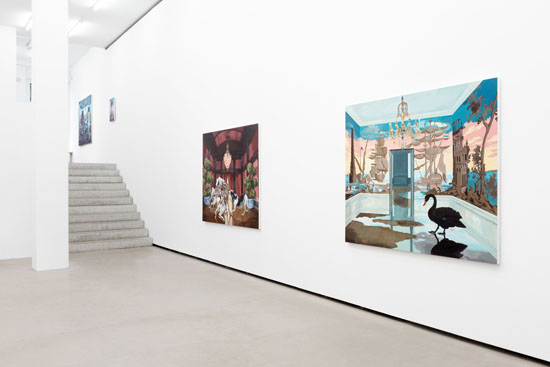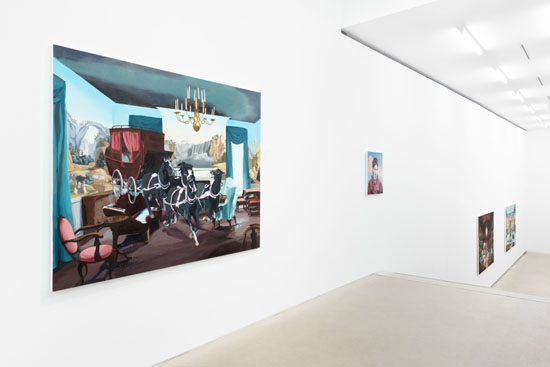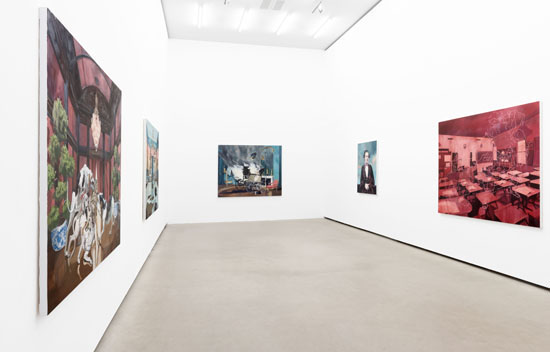Exhibitions
Archive

Melora Kuhn
21 January 2014 - 25 January 2014
Opening: Tuesday, 21 January 2014, 5-9 p.m.
See the work of Melora Kuhn
Melora Kuhn's works are a constant observation of people's experiences with themselves and in society. Kuhn makes use of the pictorial language of mythologies and history, in particular the pictorial forms of 19th-century American art history, from which she isolates individual pictures, and places them in a new context. Her interest lies in the details that were forgotten or elided in the narrative, in order to take a firmly established and well-known story in another direction and to inscribe a new readability into the personal biographies of the protagonists in her pictures. She often places the mild, classically portrayed persons in front of contrasting, destructive, black-and-white backdrops from pictures of current events. She thereby creates for each portrayed person an individual narration in which she ties personal to collective memory and lets historical events step out of the past into the present.
In her new works from the series "Reconstructing Histories", this second narrative level is added in a different way: across the scenery lie schematic contour drawings that turn the image into a picture puzzle in which one no longer knows what is in the front and what in the back or which story now actually corresponds to reality.

Tellingly, this is expressed in a portrait of Thomas Jefferson (Sally's Marks on Tom, 2013) that Melora Kuhn sets before a beautiful cloudy sky through which the sun breaks. Recognizable in a black drawing above his portrait is the figure of Sally Hemmings, a slave with whom Jefferson is said to have conceived six children, as evidenced by DNA tests done in the late 1990s. This second story, which in no way tallies with what the history books once transported, lies like a shadow on the glorious legacy of the third president of the United States.
In contrast to her portrait series, Melora Kuhn's new pictures turn to interior spaces that seem to be incorporated and overwhelmed by the story happening outside them. For example, a stagecoach that could have sprung directly out of a historical book of the 19th century, when they dashed through the Wild West, crashes through a curtain into a fancy salon, whose walls display the barren landscape of the Midwest, rather than fine tapestries. One pictorial space further, powerful English hunting dogs tear a scrubby coyote to pieces in a hall adorned with Asian porcelain. The coyote, which is no longer at home solely in America's prairies, but also in its big cities, where it is hunted as a pest and a threatening troublemaker, is venerated as a trickster spirit in Indian mythology.

Melora Kuhn's involvement with American history is a continually growing process: "I'm just trying to understand how we got to where we are now, and how it may be able to be pulled apart to figure out a new order, or a new way."
Melora Kuhn (born in 1971 in Boston) studied at the School of the Art Institute of Chicago. She has taken part in numerous solo and group exhibitions, primarily in the United States. This is her first solo exhibition in Germany. She lives and works near New York City.
TAKE FIVE
5 Weeks, 5 Artists, 5 Exhibitions
Galerie EIGEN + ART Berlin
With TAKE FIVE, the Galerie EIGEN + ART Berlin will show five exhibitions of five young artists for five weeks beginning on 14 January 2014.
The exhibitions will open weekly from Tuesday from 5 to 9 pm and be shown through Saturday. Each of the five artists has developed new works for the showing. With works that range from sculpture through painting and drawing to room installations, the gallery will thereby become the stage for a diverse exhibition program for a period of five weeks: Melora Kuhn and Lada Nakonechna have already been seen with exhibitions in the EIGEN+ART Lab; Mirjam Völker, Kristina Schuldt, and Kai Schiemenz were represented in group exhibitions in the Berlin and Leipzig galleries.
Kai Schiemenz
14 January 2014 - 18 2014
Opening: Tuesday, 14 January 2014, 5-9 p.m.
Kai Schiemenz (*1966 in Erfurt, lives and works in Berlin) focuses in his works on the city, space, and architecture and on the regulating function that these constructs carry out on people. His small-format sculptures are self-enclosed structures that combine digital techniques with natural materials like wood or paper. At the same time, they serve as models for spatially expansive installations and architectures for interiors and exteriors, in which Schiemenz uses lines of sight to construct spaces whose permeability enables them to involve the viewer directly. At the center is always the question of the influence of the built surroundings and the urban landscape on people. In his solo exhibition, Schiemenz shows two new groups of works in which the concept of architecture increasingly dissolves and the artificial materiality of the surfaces takes the foreground.
Mirjam Völker
28 January 2014 - 1 February 2014
Opening: Tuesday 28 January 2014, 5 to 9 pm
Mirjam Völker (*1977 in Wiesbaden, lives and works in Leipzig) is interested in forms of housing in her paintings. In the form of tree houses, poorly cobbled together huts, mobile homes, or vehicle cabs, they are placed like foreign objects in the midst of nature, where thickets overgrow and conquer them. These housings fail to fulfill their intended purpose, namely to provide shelter and safety from external influences, and they offer signs of discomfort and fragility instead of security and warmth. In her new large-format works on paper, provisional wooden huts stand on rickety stilts in a network of branches with no solid floor. They bear traces of former inhabitants and are now abandoned entirely to themselves and nature, which displaces them and brings them down like uninvited intruders.
Lada Nakonechna
11 February 2014 - 15 February 2014
Opening: Tuesday 11 February 2014, 5 to 9 pm
Lada Nakonechna (*1981 in Dnipropetrovsk, Ukraine, lives and works in Kiev) confronts the viewer in her drawings, installations, videos, and performances with pictures of current events and pictorial experiences from the collective memory, which she manipulates or distorts. She often lets the human being, in the form of the viewer, become a manipulative, disruptive factor who himself influences and changes a given picture. For her exhibition, Nakonechna places a tower in the middle of the gallery room; like a lighthouse, it casts a cone of light onto the surrounding walls. When trying to decipher the texts written on the walls, the viewer constantly blocks the light he needs, or is blinded and caught, and must move with the light to be able to grasp everything. The lighthouse is actually a symbol for a firm hold, a glimmer of hope on the horizon, toward which one orients oneself when one has lost one's way. But where can it lead when four high walls lock the light up in an empty room?
See the work of Lada Nakonechna
Kristina Schuldt
18 February 2014 – 22 February 2014
Opening: Tuesday 18 February 2014, 5 to 9 pm
In the pictures of Kristina Schuldt (*1982 in Moscow, lives and works in Leipzig), faceless women's bodies lie, fall, loll languorously, or bend themselves, as two-dimensional tubes. They thereby resemble smoothly polished machines more than living beings. Kristina Schuldt unashamedly makes use of the pictorial forms of Classic Modernism, but she creates her own new pictorial language, for example from the wavy hair of a Fernand Léger painting and powerful, schematized bodies that recall the avant-garde pictures of the 1920s. She exposes her figures to a garish party illumination and uses cigarettes and miniskirts to give them a nonchalance and coolness that is more reminiscent of teenagers than of mature, strong women. While in her earlier pictures the figures and their limbs were subjected and "bored into" their situation, in the new works in the exhibition, an increasing consciousness of morals comes into play and is reflected in the bodies.